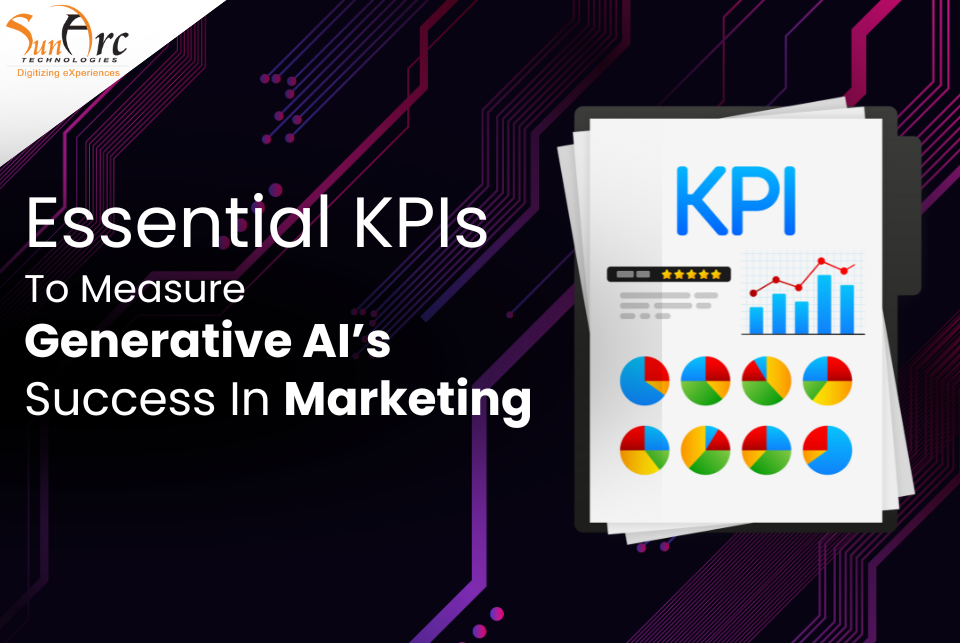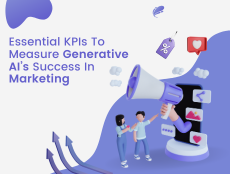Generative AI is transforming the field of marketing by empowering brands to produce customer centric content on a large scale, enhance campaign performance, and effectively connect with customers.

In order to efficiently use the power of generative AI, marketers must evaluate its effectiveness by utilizing key performance indicators (KPIs). In this blog, we are going to look into the key performance indicators (KPIs) that are crucial for assessing the effectiveness of generative AI in marketing.
1. Productivity Metrics
Why It Matters: Generative AI tools can simplify content creation, customer service, and data analysis, saving time and resources. This allows marketing teams to focus on strategic tasks and improve overall efficiency.
KPIs:
- Content Production Time: This metric measures the reduction in time taken to produce content using AI. A shorter production time indicates increased efficiency and productivity. For example, if a marketing team previously took two hours to create a blog post and now takes only one hour with AI, this shows a 50% reduction in production time.
- Automated Responses: Tracking the number of customer queries handled by AI chatbots helps assess how much of the customer support workload has been automated. A higher number of automated responses indicates the effective use of AI in customer service.
- Task Automation: This KPI measures the percentage of routine tasks automated by AI. A higher percentage of automation reflects better utilization of AI to handle repetitive tasks, freeing up human resources for more complex activities.
2. Cost-Saving KPIs
Why It Matters: AI can significantly reduce marketing costs by automating tasks and improving efficiency. This makes it crucial to measure the financial impact of AI on marketing operations.
KPIs:
- Cost Per Lead (CPL): This KPI monitors the reduction in CPL due to AI-driven lead generation. A lower CPL indicates that AI is effectively attracting potential customers at a reduced cost
- Operational Costs: Evaluating the decrease in costs from automating marketing operations provides insight into the financial benefits of AI. Lower operational costs reflect better cost management and resource utilization.
- ROI: Calculating the return on investment from AI tools helps determine their financial effectiveness. A higher ROI signifies that the benefits gained from AI investments outweigh the costs.
3. Audience Engagement Metrics
Why It Matters: AI can enhance personalization and improve customer engagement, making it important to measure how well it captures and retains user attention.
KPIs:
- Click-Through Rate (CTR): This metric measures the increase in CTR for AI-generated content. A higher CTR indicates that the content is compelling and relevant to the audience.
- Engagement Rate: Tracking user interactions with AI-driven campaigns helps assess their effectiveness in engaging the audience. Higher engagement rates suggest that the campaigns are resonating well with users.
- Conversion Rate: This KPI measures the percentage of engaged users who convert to customers. A higher conversion rate indicates that AI-driven engagement is effectively driving sales or desired actions.
4. Campaign Performance Metrics
Why It Matters: AI can optimize campaign strategies and improve overall performance, making it essential to measure its impact on campaign success.
KPIs:
- Campaign Reach: This metric measures the audience size reached through AI-optimized campaigns. A larger reach indicates that AI is effectively expanding the campaign’s visibility.
- Lead Generation: Tracking the number of leads generated by AI campaigns helps evaluate their effectiveness in attracting potential customers.
- Sales Growth: This KPI measures the increase in sales from AI-driven marketing efforts. Higher sales growth indicates that AI is contributing to revenue generation.
5. Output and Creative Quality Metrics
Why It Matters: AI can enhance the quality of creative content, leading to better audience reception. Measuring these metrics ensures that AI-generated content meets high standards.
KPIs:
- Content Quality Scores: Using tools to assess the quality of AI-generated content helps maintain high creative standards. Higher quality scores indicate that the content is valuable and well-crafted.
- Audience Feedback: Gathering feedback on the creativity and relevance of AI content provides insights into its effectiveness. Positive feedback indicates that the content resonates well with the audience.
- Engagement Duration: This metric measures the time users spend engaging with AI-created content. Longer engagement durations suggest that the content is engaging and meets user needs.
Conclusion
When evaluating the effectiveness of generative AI in marketing, it is important to take an integrated approach. This involves considering various factors such as productivity, cost savings, engagement levels, campaign performance, and the quality of creative output.
By prioritizing these key performance indicators, marketers can accurately assess the influence of AI and make smart decisions to improve their strategies.

